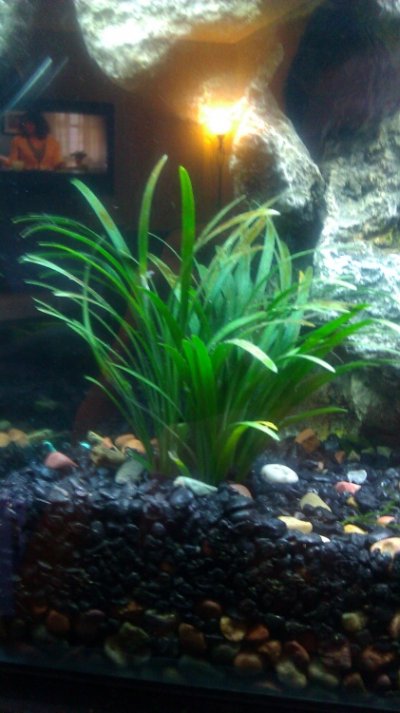What kind of "grass" like plant did you get?
You have 2WPG... what kind of bulbs/fixture is it?
You may or may not need fertilizers... depending on a lot of factors. Here are the general things needed for plants to grow:
The big things:
1. Light - you have this covered... minimum of 1 watt per gallon for low light plants...
2. Carbon - This comes in a few forms... your plants will use CO2 in the water to get this. Without injecting CO2 your water will remain at equilibrium with the air, around 7ppm CO2. By injecting CO2 you can raise the CO2 to "unnatural" levels and essentially kick the plants into high gear. The consensus is the most beneficial level is somewhere between 20-40ppm CO2. You can also add Carbon by using a product called "seachem excel". It works very well with most plants, but can cause problems with others (namely hornwort, anacharis, and a few others) so read up on it before putting it in your tank.
3. Nitrogen (N): One of the 3 "macro-nutrients" for plant growth. If you have fish in your tank, there is a natural source of N provided by fish waste and uneaten food, in the form of ammonia, nitrite, and nitrates. Your plants will soak up these forms of N and use them to grow. As you add more light to a tank, especially if it is heavily planted, your plants may use up all of the N in your tank, and it may become necessary to supplement the N using fertilizer. This can be done with liquid N supplements, or using the dry powder form of KNO3.
4. Phosphorus (P): the 2d of the 3 macro-nutrients. It occurs naturally in many water sources, and is also found in many foods and other organic material. It may be necessary to dose P in high light tanks where the plants are using up all available naturally occurring P. It occurs in the tank in the form of Phosphate, PO4... so you can get a phosphate test kit to check how much P your plants have available to use if you suspect you are experiencing P deficiency. It can be dosed using a liquid P supplement (like flourish P) or by using dry powder KH2PO4.
5. Potassium (K): The last of the 3 macro-nutrients. K doesn't occur naturally in much that is already in a standard tank. Most off the shelf aquarium fertilizers contain K (and not the other 2 macros). It is less harmful in large quantities, and almost any tank (from low to high) will benefit from the addition of a supplement that contains K. It is also available in liquid form, or can be dosed using K2SO4.
The micro-nutrient or trace elements:
Plants also need other nutrients in much smaller quantities that are often referred to as micro-nutrients or trace elements. These include Iron (Fe), the most common trace element added, and a commonly available fertilizer. It also includes other elements, like Boron, Mg, etc.
Most ferts you find in your local fish store will be a liquid form that combines 1 or more of the nutrients I described above. Most serious FW Planted tank hobbyists prefer to dose each of the 4 categories above individually using dry fertilizers. You can buy enough dry fert to last years for a tank of your size for about $20-30. The liquid ferts sold in LFSs are very expensive in comparison, sometimes costing 20-70 times as much if you add up what you are getting per dose.
In addition to liquid dosing or dry dosing to the water column, there are also "root tabs" available that get "planted" in the substrate under the plants. They can do wonders for plants that are heavy root feeders. They contain 1 or more of the categories of ferts (N, P, K, or trace) I described above.
As far as the plants in pots, you can leave them in and they will probably be fine. They will grow quicker and spread faster however if they are removed from the pots/rock wool and planted directly in the substrate.

